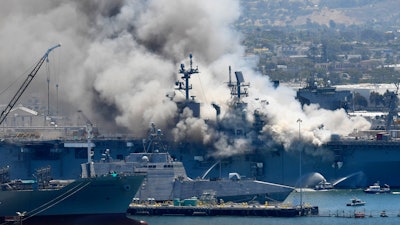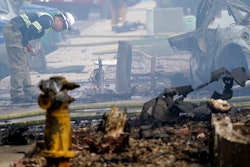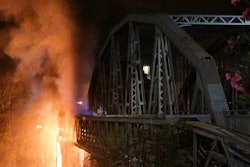
WASHINGTON (AP) — A Navy report has concluded there were sweeping failures by commanders, crew members and others that fueled the July 2020 arson fire that destroyed the USS Bonhomme Richard, calling the massive five-day blaze in San Diego preventable and unacceptable.
While one sailor has been charged with setting the fire, the more than 400-page report, obtained by The Associated Press, lists three dozen officers and sailors whose failings either directly led to the ship's loss or contributed to it. The findings detailed widespread lapses in training, coordination, communication, fire preparedness, equipment maintenance and overall command and control.
“Although the fire was started by an act of arson, the ship was lost due to an inability to extinguish the fire,” the report said, concluding that “repeated failures” by an “inadequately prepared crew” delivered "an ineffective fire response."
It slammed commanders of the amphibious assault ship for poor oversight, and said the main firefighting foam system wasn't used because it hadn't been maintained properly and the crew didn't know how to use it. The report is expected to be released Wednesday.
U.S. Navy officials on Tuesday said that while crews at sea consistently meet high firefighting standards, those skills drop off when ships move into maintenance periods. The Bonhomme Richard was undergoing maintenance at the time of the fire.
During maintenance there are more people and organizations involved with the ship, including contractors. And the repairs often involve equipment and chemicals that present different hazards and challenges.
The report describes a ship in disarray, with combustible materials scattered and stored improperly. It said maintenance reports were falsified, and that 87% of the fire stations on board had equipment problems or had not been inspected.
It also found that crew members didn't ring the bells to alert sailors of a fire until 10 minutes after it was discovered. Those crucial minutes, the report said, caused delays in crews donning fire gear, assembling hose teams and responding to the fire.
Sailors also failed to push the button and activate the firefighting foam system, even though it was accessible and could have slowed the fire's progress. “No member of the crew interviewed considered this action or had specific knowledge as to the location of the button or its function,” the report said.
The report spreads blame across a wide range of ranks and responsibilities, from the now retired three-star admiral who headed Naval Surface Force Pacific Fleet — Vice Adm. Richard Brown — to senior commanders, lower ranking sailors and civilian program managers. Seventeen were cited for failures that “directly” led to the loss of the ship, while 17 others “contributed” to the loss of the ship. Two other sailors were faulted for not effectively helping the fire response. Of the 36, nine are civilians.
Adm. William Lescher, the vice chief of naval operations, has designated the commander of U.S. Pacific Fleet to handle any disciplinary actions for military members. The Navy officials said the disciplinary process is just beginning. One official said the key challenge in making improvements will be addressing the “human factor,” including leadership skills and ensuring that everyone down to the lowest ranking sailors understands their responsibilities, and can recognize problems and correct them.
The officials spoke on condition of anonymity to discuss the report ahead of its public release.
Specifically, the report said failures of Vice Adm. Brown; Rear Adm. Scott Brown, the fleet maintenance officer for the Pacific Fleet; Rear Adm. William Greene, the fleet maintenance officer for U.S. Fleet Forces Command; Rear. Adm. Eric Ver Hage, commander of the regional maintenance center; Rear Adm. Bette Bolivar, commander of Navy Region Southwest; Capt. Mark Nieswiadomy, commander of Naval Base San Diego; and Capt. Tony Rodriguez, commander of Amphibious Squadron 5, all “contributed to the loss of the ship.”
The report also directly faults the ship’s three top officers — Capt. Gregory Thoroman, the commanding officer; Capt. Michael Ray, the executive officer; and Command Master Chief Jose Hernandez — for not effectively ensuring the readiness and condition of the ship.
“The execution of his duties created an environment of poor training, maintenance and operational standards that directly led to the loss of the ship," the report said of Thoroman. And it said Ray, Hernandez and Capt. David Hart, commander of the Southwest Regional Maintenance Center, also failed in their responsibilities, which directly led to the loss of the ship.
The report only provides names for senior naval officers. Others were described solely by their job or rank.
More broadly, the crew was slammed for “a pattern of failed drills, minimal crew participation, an absence of basic knowledge on firefighting” and an inability to coordinate with civilian firefighters.
“The loss of the USS Bonhomme Richard was a completely avoidable catastrophe,” said U.S. Rep. John Garamendi, D-Calif., chairman of the House Armed Services readiness subcommittee. He said he read the report “with shock and anger,” and will look into the matter carefully to “determine the full extent of the negligence and complacency that occurred.”
The ship was undergoing a two-year, $250 million upgrade pierside in San Diego when the fire broke out. About 115 sailors were on board, and nearly 60 were treated for heat exhaustion, smoke inhalation and minor injuries. The failure to extinguish or contain the fire led to temperatures exceeding 1,200 degrees Fahrenheit in some areas, melting sections of the ship into molten metal that flowed into other parts of the ship.
Due to the damage, the Navy decommissioned the ship in April. In August, Seaman Apprentice Ryan Mays was charged with aggravated arson and the willful hazarding of a vessel. He has denied setting the fire.
The blaze began in the lower storage area, which Mays’ duty station had access to, according to a court document. Investigators found three of four fire stations on the ship had evidence of tampering, including disconnected firehoses, and highly flammable liquid was found near the ignition site.
Efforts to put out the fire were hampered because the ship’s crew and other outside fire response departments and organizations were not coordinated, couldn’t communicate effectively, hadn’t exercised together and weren’t well trained, the report said.
The report, written by Vice Adm. Scott Conn, included a number of recommended changes and improvements that have been endorsed by Lescher. The Navy set up a new fire safety assessment program that conducts random inspections, and has taken steps to increase training. Nearly 170 of those inspections have already been done, and officials said they are finding good results.
The Navy also conducted a historical study, looking closely at 15 shipyard fires over the last 12 years. It found recurring trends including failures to comply with fire prevention, detection and response policies.
As a result, Navy leaders are expanding the staffing and responsibilities of the Naval Safety Center to perform audits and unannounced assessments of Navy units. The final costs are still being calculated.






















